Round aquariums: sizes, selection and design
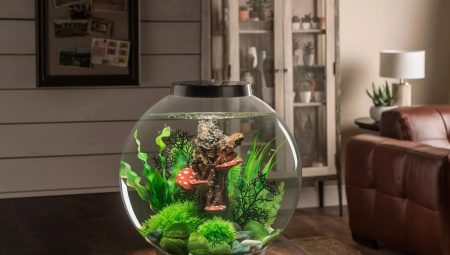
Despite much criticism from professionals, round aquariums are often found in many homes. Such options can be seen both in offices and in apartments. Surely many aquarists remember their first, not always successful, experiments in creating the underwater world, associated with a round aquarium.
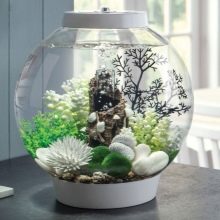
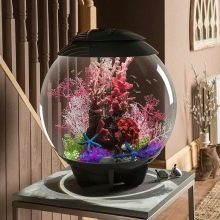
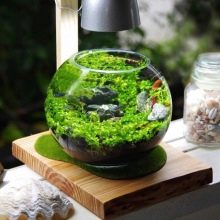
Advantages and disadvantages
Why is a round aquarium so attractive? Let us give several reasons in its favor.
- A pond of this shape, if properly designed and well-groomed, looks appropriate in almost any interior.
- The all-glass or acrylic construction is completely leak-free, which allows the aquarium to be installed on any surface.
- The inner space of the reservoir is maximally accessible for observation.
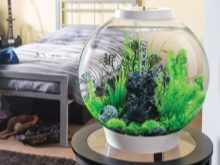
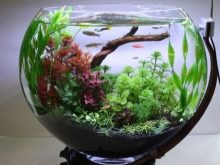
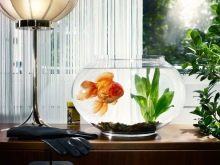
As you can see, all the arguments in favor of an artificial reservoir of this form come from the needs and desires of an apartment dweller or an office owner. There are much more statements by opponents of the round aquarium.
- The volume of standard round aquariums is usually small to form a stable biological system. The aquarium is easily permeable to natural light, therefore, there is an intense overgrowth of algae on the glass, which requires frequent cleaning. Such a body of water requires frequent intensive and careful maintenance, and this is the cause of serious stress for most fish.
- The convex glass surface completely distorts reality, as a result of which the inhabitants of the aquarium are constantly stressed, even with little movement.
- The small volume of the aquarium is suitable for a comfortable habitation of only a small number of fish, which is completely unacceptable for schooling species.
- The shape of the reservoir leaves little water surface area, which makes gas exchange with the atmosphere difficult, and some inhabitants may experience a lack of oxygen.
- Likewise, the surface of the soil at the bottom of the aquarium is small. This does not allow the amount of plants to be diluted in a reservoir sufficient for self-regulation of many processes.
- Special equipment is required to set up a round aquarium. Standard aeration and filtration systems are not suitable due to the fact that they will take up a significant volume of an already small reservoir, and they are also difficult to hide and give the aquarium an aesthetic appearance. It is more difficult to acquire suitable equipment, it costs more than usual.
- In a round aquarium, it is almost impossible to create shelters for fish, from the absence of which many of them experience stress, which affects their lifespan.

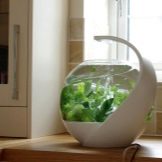
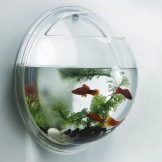
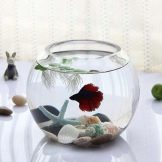
As you can see, the arguments against a round aquarium are related to the creation of acceptable conditions for its inhabitants. It follows that such an aquarium is completely unsuitable for a beginner. It is better for a beginner aquarist to master a rectangular reservoir with a volume of at least 40 liters. This will avoid many disappointments and even small tragedies. It is better to make a round aquarium just decorative, without any claims to imitate the natural habitat. The main focus should be on the aesthetics and harmony of the aquarium as an element of the interior.
Size options
Technologically, a round aquarium is easier to manufacture with a small volume. Currently, small spherical cans with a volume of 2 to 5 liters have become widespread. They are used as a decorative accessory even when planting indoor plants. Pet shops offer a fully equipped small aquarium with a built-in filter fountain that doubles as an aerator with a special light and stand.
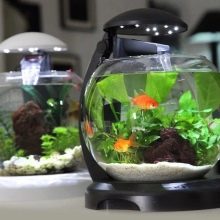
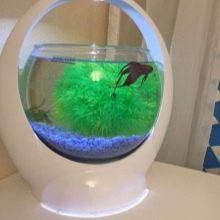
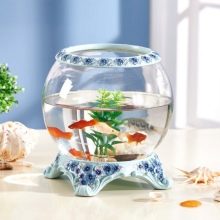
The most common are still more voluminous spherical banks. In a 10 liter container, you can already try to place 2-3 medium-sized fish with relative comfort. If the area of the room allows, then you can fit into the interior and a spherical aquarium of 20 liters. It should be noted that a large round reservoir with a volume of more than 30 liters will require significantly more space than a rectangular aquarium of the same volume. Spheres of this and larger volume are very rarely on sale.
Cylindrical round aquariums of large volumes are also rare. Round aquariums are often sold without a lid. Choosing it, you must not be mistaken with the size. The inside diameter of the lid should match the top outside diameter of the can.
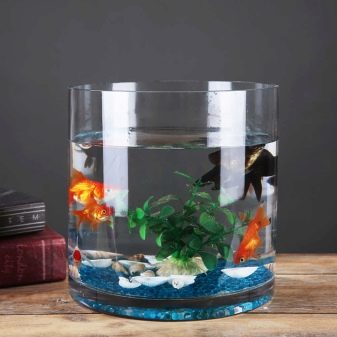
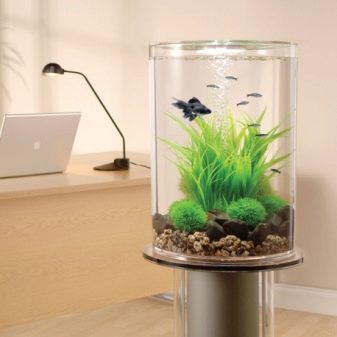
Materials (edit)
Round aquariums are still made of glass, as they used to be. The material is traditional, perfectly mastered, however, heavy and fragile. A glass aquarium of 5 liters, with a wall thickness of up to 3 mm, can even weigh up to 1.5 kg without water and soil, and a 30-liter one with walls at least 5 mm thick can “stretch” all 3 kg. And if with water and everything else, then its weight can reach up to 50 kg. It is very difficult to accidentally drop such a massive object. Still, glass remains a very fragile material, and this argument often does not sound in its favor.
Currently, as traditional materials are increasingly being replaced by new ones with similar properties, glass sphere aquariums are being replaced by plastic... A plastic, or rather, acrylic container with the same transparency is much lighter. It is impossible to break it by accident. This aquarium is easier to handle and maintain. However, the new material also has its drawbacks.
When cleaning the inner surface from algal fouling, do not use a scraper, as scratches will appear, which will never be on the glass.
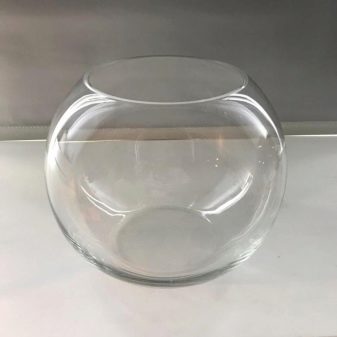
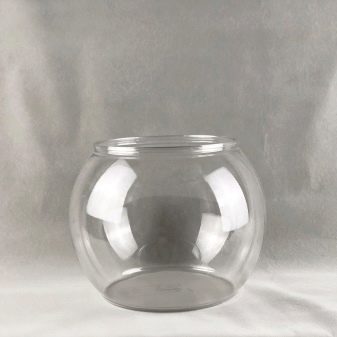
How to choose?
When choosing an aquarium-sphere, first of all, it is necessary to take into account its harmony in the interior. Using a variety of color schemes, it can be placed in a room made in almost any style. Lighting, colored stones and artificial plants in your aquarium design will help you align your aquarium with the overall design. So, for historical and ethnic interiors, a spherical aquarium of large volumes, at least 20 liters, with natural soil of coarse sand and pebbles and real plants is more suitable.
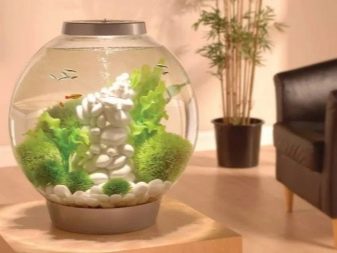
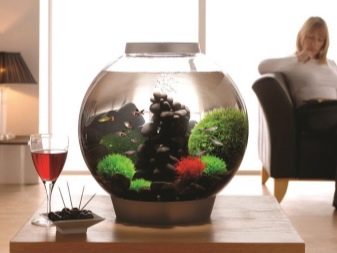
Aquariums devoid of fish, but with lush vegetation will look beautiful. Contemporary styles (loft, minimalism, postmodernism, techno and hi-tech) require the appropriate design of the sphere. It is better if it is small, with a minimum of decor. In some cases, decorative stones of a certain color are suitable. Plants in such a container may be superfluous.
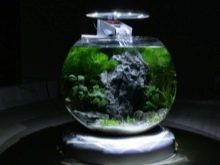
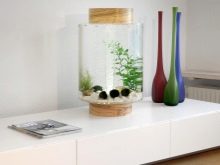

Where and how to install?
Setting up a round aquarium is more troublesome than setting up a rectangular aquarium. The latter, as a rule, is installed on a special pedestal or rack, one of the functions of which is some protection of the reservoir from accidental influences. A round aquarium is completely open not only for views, but also for any accidents.
It is necessary to think over the place of installation of the round jar as carefully as possible. It should not be on someone's path, interfere with simple actions: pull the curtain open, turn on the light, etc. But at the same time, the container should remain noticeable and attractive to the eyes of any visitor who has entered the room again.
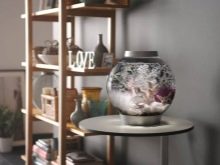
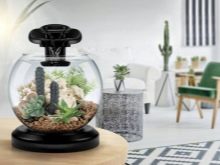

One of the problems with round aquariums is their accessibility to children. In this case, it is important to take into account the danger posed by such a container of water for the child. First of all, the sphere must be installed on a special stand to ensure its stability. Curbstones or other furniture on which the container will be installed must be reliable. In some cases, it is advisable to fix them to the wall to avoid tipping over with the aquarium.
Besides, the sphere must be placed away from heating appliances, due to the small volume, this can provoke strong temperature jumps, which is undesirable for the inhabitants of the reservoir. The proximity of a window can provoke an increased growth of algae, which will lead to the coating of the walls with a green coating. When setting up a round aquarium, you will have to take into account the intensity of natural light.
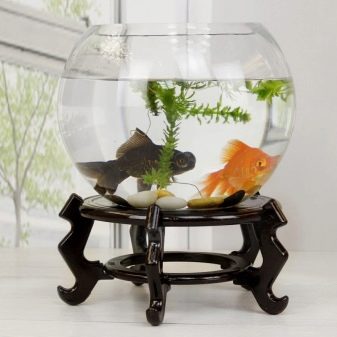
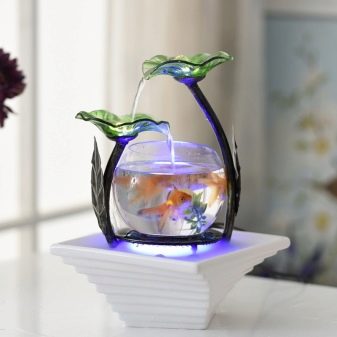
How to equip?
Equipping a round aquarium is much more complicated than a classic rectangular pond. It is more difficult to equip it due to the convex shape of the walls and the relatively small area of the bottom. Conventional equipment will be difficult to camouflage, resulting in even greater volume reduction. Special equipment for a round aquarium is much more difficult to find in pet stores. However, this is perhaps the only way to properly design a sphere if it is planned to keep fish or living plants in it.
It is much easier to start an aquarium with ready-made equipment. Such ponds are manufactured by some companies specializing in aquarium equipment. Aquariums are sold with lighting and a waterfall (an original way to combine aeration and filtration systems).
Lighting a round aquarium is one of the design challenges. It is impossible to use an ordinary lamp due to its rather large dimensions, and the use of a table lamp, although convenient, is not always aesthetically pleasing.
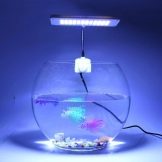
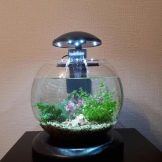
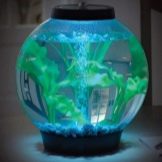
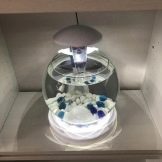
As already noted, the decor of a round aquarium is a very important matter. Therefore, its equipment must be approached with great care, spheres with inappropriate accessories look rather ridiculous.In such an aquarium, colored soil and artificial plants will not be superfluous, because its main task is to emphasize the style of the room, and for this you often have to sacrifice the comfort of the inhabitants.
There is also such a solution as a sphere in which not only inhabitants are absent, but also water. In this case, colored stones and artificial plants perform decorative functions. Often, an ordinary houseplant is placed in such containers. Such a decorative element of the interior, of course, cannot be called a full-fledged aquarium. In the second half of the 20th century, round reservoirs with colored stones instead of soil began to be installed in modern interiors, completely devoid of vegetation, with one fish of bright colors, also performing purely decorative functions.
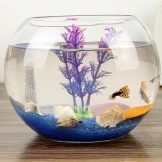
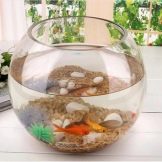
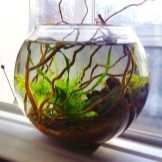
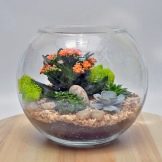
How to contain?
The maintenance of a round aquarium, due to its relatively small volume, is much more difficult than a rectangular one. A small amount of soil requires intensive filtration and constant water changes. If such a body of water is overpopulated with fish, it is impossible to create a stable balance in it. It is such aquariums, overflowing with fish, that require weekly water changes and complete cleaning of the soil and walls.
Thus, a fishbowl may not be the first milestone in hobbyists, it is a common mistake that leads to huge frustrations. Proper care of such a body of water is possible only with some experience. Here are some simple rules that can help you create a balanced biological system even in a relatively small circular aquarium.
- Moderation in everything. Avoid overcrowding a round aquarium.
- It is best to place the sphere in the least-lit area to reduce the natural light that favors the development of algae.
- Constant observation of the inhabitants, the stresses common for an aquarium-sphere, can provoke the appearance of various diseases.
- If there is no filter, the water will have to be changed daily with simultaneous blowing of the soil.
- Daily monitoring of the water condition (smell, transparency, chemical composition).
Compliance with these simple rules will require the aquarist to pay close attention to the area.
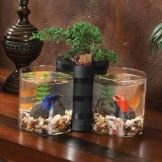

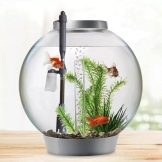
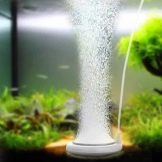
How many and what kind of fish can you keep?
Sphere aquarium is not the right place for many fish. Let's start with those elementary restrictions that the owner of such an artificial reservoir will have to put up with.
- Schooling fish (neons, zebrafish) will feel cramped.
- Very active fish (many barbs, small cichlids, swordtails) cannot live in the sphere, since they will experience constant stress due to the refraction of light, which causes distortion of space and a rapid change of light and shadow.
- Large fish (cichlids, golden fish) also cannot be placed in the sphere due to its small volume.
- Lovers of digging in the ground - various types of catfish and all the same cichlids will not be able to do this, since there is very little soil in a round aquarium.
- And, of course, all shy fish will live in the sphere for a very short time, since they will not be able to find secluded corners and shelters that allow them to feel safe.

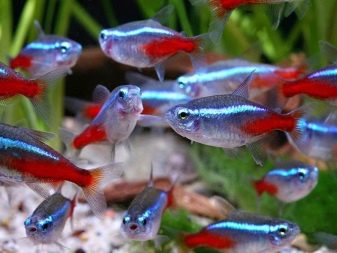
Whom to get if you still need to revive the round aquarium? From the above examples, it follows that most popular aquarium fish cannot live in such a reservoir. Single fish, especially cockerels, are perfect for a round aquarium. Guppies are also a good option, the fish are completely indifferent to many of the inconveniences of the sphere so much that they easily reproduce, and over time, the overgrown flock will find itself in very uncomfortable conditions.
Experienced aquarists recommend keeping a small flock of 3-4 males of these fish in a round decorative aquarium. Their closest relatives - platies and mollies - also live well in such reservoirs as part of a small flock of 3-4 individuals. A school of 3 lalius, calm and hardy fish, is quite capable of reviving such a reservoir.One large or 3 small gourami fish will also do well in a round aquarium.
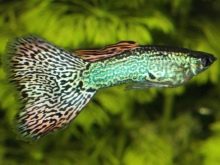
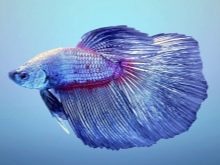
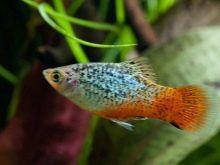
Not all aquarium plants are suitable for a sphere. There is not much soil here, and plants with a powerful root system will not survive. Constant water changes and sudden changes in its parameters also limit the possibilities of growing plants in a small aquarium, which is practically all areas.
Unpretentious plants can be considered the most suitable: vallisneria, small cryptocorynes, Indian and Thai ferns, elodea, hornwort.
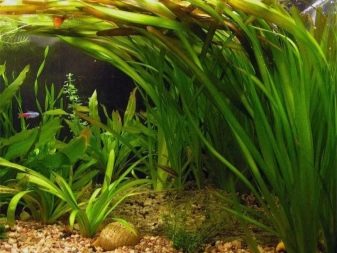
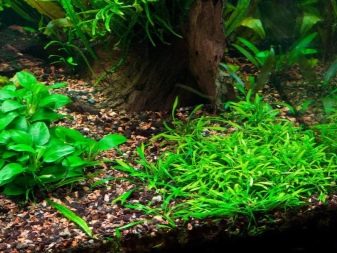
For the care and problems of keeping a round aquarium, see the video.








